Punjab State Board PSEB 11th Class Maths Book Solutions Chapter 11 Conic Sections Miscellaneous Exercise Questions and Answers.
PSEB Solutions for Class 11 Maths Chapter 11 Conic Sections Miscellaneous Exercise
Question 1.
If a parabolic refletor is 20 cm in diameter and 5 cm deep, find the focus.
Answer.
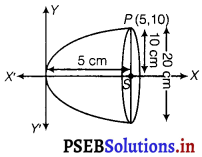
Taking vertex of the parabolic reflector at origin, X-axis along the axis of parabola.
The equation of the parabola is of the fonn y2 = 4ax.
Given, depth is 5 cm and diameter is 20 cm.
∵ Point P(5, 10) lies on parabola.
∴ (10)2 = 4a(5) = a = 5
Clearly, focus is at the mid-point of given diameter i.e., S(5, 0).
![]()
Question 2.
An arch is in the form of a parabola with its Rxi vertical. The arch is 10 m high and 5 m wide at the base. How wide Is it 2m from the vertex of the parabola?
Answer.
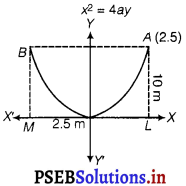
Let the vertex of the parabola be at the origin and axis be along OY.
Then, the equation of the parabola is
x2 = 4ay
The coordinates of end A of the (2.5, 10) and it lies on the eq. (i).
∴ (25)2 = 4a × 10
⇒ a = \(\frac{6.25}{40}=\frac{5}{32}\) ……………(ii)
On putting the value of a from eq. (ii) in eq.(i), we get
x2 = 4(\(\frac{5}{32}\))y ………………..(iii)
On substituting y = 2 in eq. (iii), we get
x2 = \(\frac{5}{8}\) × 2
⇒ x2 = \(\frac{5}{4}\)
⇒ x = \(\frac{\sqrt{5}}{2}\) m.
Hence, the width of the arc at a height of 2 m from vertex is 2 × \(\frac{\sqrt{5}}{2}\) i.e., √5 m.
![]()
Question 3.
The cable of a uniformly loaded suspension bridge hangs in the form of a parabola. The roadway which is horizontal and 100 m long is supported by vertical wires attached to the cable, the longest wire being 30 m and the shortest being 6m. Find the length of a supporting wire attached to the roadway 18 m from the middle.
Answer.

The cable is in the form of a parabola x2 = 4ay.
Focus is at the middle of the cable, the shortest and longest vertical supports are 6 m and 30 m and roadway is 100 m long.
Since, point A(50, 24) lies on parabola x2 = 4ay.
(50)2 = 4a(24)
= 4a = 625
Equation of parabola is x2 = \(\frac{625}{6}\) y
[Put 4a = \(\frac{625}{6}\)]
Let the support at 18 m from middle be l m, then B(18, l – 6) lies on the parabola.
∴ (18)2 = \(\frac{625}{6}\) (l – 6)
l = \(\frac{18 \times 18 \times 6}{625}\) + 6
= 3.11 + 6 = 9.11 (approx)
Hence, the length of supporting wire is 9.11 m.
![]()
Question 4.
An arch is in the form of a semi-ellipse. It is 8 m wide and 2m high at the centre. Find the height of the arch at a point 1.5 m from one end.
Answer.
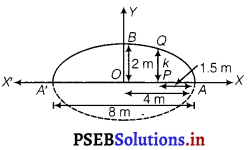
Clearly, equation of ellipse is of the form \(\frac{x^{2}}{a^{2}}+\frac{y^{2}}{b^{2}}\) = 1 ……………(i)
Here, it is given that, 2a = 8 and b = 2.
⇒ a = 4 and b =2
On putting the values of a and b in eq. (i), we get
\(\frac{x^{2}}{16}+\frac{y^{2}}{4}\) = 1
which is required equation.
Given, AP = 1.5 m
∴ OP = OA – AP = 4 – 15
OP = 25m
Let PQ = k
∴ Coordinate of Q (2.5, k) will satisfy the equation of ellipse.

![]()
Question 5.
A rod of length 12 cm moves with its ends always touching the coordinate axes. Determine the equation of the locus of a point P on the rod, which is 3 cm from the end in contact with the x-axis.
Answer.
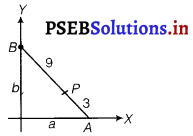
Let l be the length of the rod and at any position meet X-axis at A(a, 0) and Y-axis at B(0, b), so that
l2 = a2 + b2
⇒ (12)2 = a2 + b2 …………….(i) [∵ l = 12]
Let P be the point on AB which is 3 cm from A and hence 9 cm from B.

This means that P divides AB in ratio 3 : 9 i.e., 1 : 3.
If P = (x, y), then by section formula, we have
(x, y) = \(\left(\frac{1 \times 0+3 \times a}{1+3}, \frac{1 \times b+3 \times 0}{1+3}\right)\)
(x, y) = \(\left(\frac{3 a}{4}, \frac{b}{4}\right)\)
⇒ x = \(\frac{3 a}{4}\)
⇒ a = \(\frac{4 x}{3}\) and b = 4y
On putting the values of a and b in eq. (i), we get
144 = (\(\frac{4 x}{3}\))2 + (4 y)2
⇒ 1 = \(\frac{x^{2}}{9 \times 9}+\frac{y^{2}}{9}\)
⇒ \(\frac{x^{2}}{81}+\frac{y^{2}}{9}\) = 1
which is required equation.
![]()
Question 6.
Find the area of the triangle formed by the lines joining the vertex of the parabola x2 = 12y to the ends of its latus rectum.
Answer.
The given parabola is x2 = 12y.
On comparing this equation with x2 = 4ay, we obtain
4a = 12
⇒ a = 3.
The coordinates of foci are S (0, a) = S (0, 3)
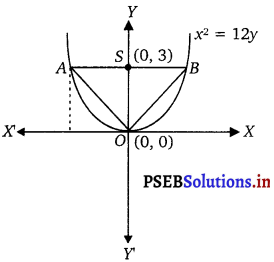
Let AB be the latus rectum of the given parabola.
The given parabola can be roughly drawn as
At y = 3, x2 = 12 (3)
x2 = 36
⇒ x = ± 6.
The coordinates of A are (- 6, 3), while the coordinates of B are (6, 3).
Therefore, the vertices of ∆OAB are 0 (0, 0), A (- 6, 3), and B (6, 3).
Area of ∆OAB = \(\frac{1}{2}\) |0 (3 – 3) + (- 6) (3 – 0) + 6 (0 – 3)|
= \(\frac{1}{2}\) |(- 6)(3) + 6(- 3)| unit2
= \(\frac{1}{2}\) |- 18 – 18| unit2
= \(\frac{1}{2}\) |- 36| unit2
= \(\frac{1}{2}\) × 36 unit2
= 18 unit2
Thus, the required area of the triangle is 18 unit2.
![]()
Question 7.
A man running a racecourse notes that the sum of the distances from the two flag posts from him is always 10 m and the distance between the flag posts is 8 m. Find the equation of the posts traced by the man.
Answer.
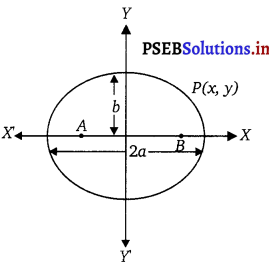
Let A and B be the positions of the two flag posts and P(x, y) be the position of the man. Accordingly, PA + PB = 10.
We know that if a point moves in a plane in such a way that the sum of its distances from two fixed points is constant, then the path is an ellipse and this constant value is equal to the length of the major axis of the ellipse.
Therefore, the path described by the man is an ellipse where the length of the major axis is 10 m, while points A and B are the foci.
Taking the origin of the coordinate plane as the centre of the ellipse, while taking the major axis along the x-axis, the ellipse can be diagrammatically represented as.
The equation of the ellipse will be of the form \(\frac{x^{2}}{a^{2}}+\frac{y^{2}}{b^{2}}\) = 1 , where a is the semi-major axis.
Accordingly, 2a = 10
⇒ a = 5.
Distance between the foci, 2c = 8
⇒ c = 4
On using the relation c = \(\sqrt{a^{2}-b^{2}}\) we obtain 4 = \(\sqrt{25-b^{2}}\)
⇒ 16 = 25 – b2
⇒ b = 25 – 16 = 9
⇒ b = 3
Thus, the equation of the path traced by the man is \(\frac{x^{2}}{25}+\frac{y^{2}}{9}\) = 1.
Question 8.
An equilateral triangle is inscribed in the parabola y =4ax, where one vertex is at the vertex of the parabola. Find the length of the side of the triangle.
Answer.
Given, equation of parabola is y2 = 4ax.
Let p be the side of equilateral ∆OAB, whose one vertex is the vertex of parabola.
Then, by symmetry, AB is perpendicular to the axis ON of parabola.
Let ON = x, then BN = \(\frac{p}{2}\)
Since, B(x, \(\frac{p}{2}\)) lies on parabola.
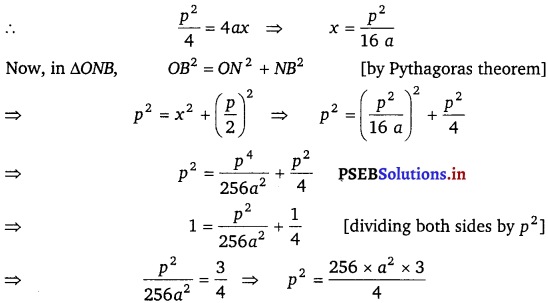
⇒ p2 = 64 × 3 × a2
⇒ p = 8a√3
Hence, side of an equilateral triangle is 8a√3.
